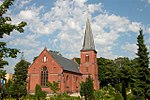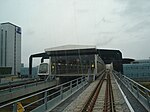Copenhagen Airport, Kastrup (Danish: Københavns Lufthavn, Kastrup, pronounced [kʰøpm̩ˈhɑwns ˈlɔftˌhɑwˀn ˈkʰæˌstʁɔp]; IATA: CPH, ICAO: EKCH) is an international airport serving Copenhagen, Denmark, Zealand, the Øresund Region, and southern Sweden including Scania. It is the second largest airport in the Nordic countries.
As of 2019, the airport was the largest airport in the Nordic countries with close to 30.3 million passengers. It is one of the oldest international airports in Europe, the fourth-busiest airport in Northern Europe, and the busiest for international travel in Scandinavia.The airport is on the island of Amager, 8 kilometres (5 miles) south of Copenhagen city centre, and 24 km (15 mi) west of Malmö city centre, to which it is connected by the Øresund Bridge. The airport covers an area of 11.8 km2 (4.6 sq mi). Most of the airport is in the municipality of Tårnby, with a small part in the city of Dragør.
The airport is the main hub out of three used by Scandinavian Airlines and is also an operating base for Sunclass Airlines and Norwegian Air Shuttle. Copenhagen Airport handles around 60 scheduled airlines, and has a maximum operation capability of 83 operations/hour, and a total of 108 jet bridges and remote parking stands. Unlike other Scandinavian airports, most of the airport's passengers are international. In 2015, 6.1% of passengers travelled to and from other Danish airports, 83.5% to/from other European airports, and 10.4% were intercontinental passengers. The airport is owned by Københavns Lufthavne, which also operates Roskilde Airport. The airport employs 1,700 people (not including employees in shops, restaurants, etc.).Copenhagen Airport was originally called Kastrup Airport, after the small town of Kastrup, now part of the Tårnby municipality. The formal name is still Copenhagen Airport, Kastrup, to distinguish it from Roskilde Airport.











